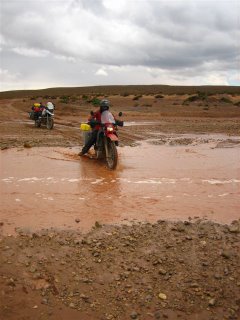After the dodgy Bolivian crossing, we go to the other side and over to the Peruvian border. This one is in the middle of a busy town though and for the first time, we are a little worried about the bikes while we´re in dealing with the paperwork thanks to the number of touts and twats in the vicinity. I´m glad I took Matt Cartney´s advice and bought a cheep alarm as it gives me some peace of mind when I´m away from my bike.
The proceedures take a lot longer than we´re used to however this time, we manage to successfuly get the bikes paperwork sorted out. We plan to get to Puno by Lake Titticaca, tonight but thats clearly not going to happen and we only make it to a town called Juli at nightfall. We get to Puno the following morning and get checked into a hotel (Don Julio)which involves several narrow planks to get the bikes up a few steps and into the hotel lobby.
From here we take a boat trip over to Isle Taquile where there are no roads or vehicles and the locals rarely marry outside their island. The men wear coloured knitted hats a bit like nightcaps that they knit themselves, red indicating a man is married while red and white indicate single status. Other colours imply a mans social status such as a senior figure while the women seem to spin wool all day long. We take a local boat owned by the islanders, rather than the tour companies which ply for business at the port (Michelle is good at reading about stuff like this, I would have just plopped myself on the first boat I found). We have also left the bikes at the hotel as we will spend a night on the island and return to Puno the following day. The boat takes around 4 hours to get to the lsland and we meet Elissio, our native guide. We will be crashing at his pad tonight and we´ll be given dinner and breakfast for 25 Soles each.
Enroute, the boat stops at one of the Uros Islands, these are the floating reed islands that the Uros people have lived on for hundreds of years. They make tacky trinkets for selling and reed boats while living off fish and tourists. We are only on the island for about 20 minutes which is long enough for me and to spot a tv inside one of the reed huts.
After about 4 hours, we arrive on Isle Taquile. While climbing an incredibly steep path which leads up to the square, Elissio explains to us and another couple who are also staying, that the island is split into 6 areas and that the crops are rotated on an anual basis, mainly potatos and maize. There are around 1500 inhabitants on the island and I´d guess at maybe 300 dwellings. Each property has land used for growing crops however that doesn´t make them totally self sufficient and to this end, this is where the knitting comes in. The islanders produce various knitted products like hats, belts and clothing that are sold to tourists and presumably exported which pays for things like sugar and cable tv. The kids have a trade of their own and while the tourist boats are only on the island between 12 and 2pm, they strut their stuff in the square selling little friendship bracelets and pose for tourist photos wearing their traditional dress and generally holding lambs, all for ´una sole´.
As you walk about the island, the kids pop up from nowhere behind stone walls and whisper (they all whisper here, there´s nothing to compete with) ´photo, photo, una sole´. Its a beautiful island and the people all seem to walk about smiling, maybe they know something we don´t? We have dinner with the other 3 guests and its off to bed in our candle-lit room where I have to duck to avoid the low timber beams. The toilet like all those on the island requires to be flushed with a scoop of rainwater from a barrel. There´s a great little beach we walk to the following morning at the far end of the island but the water´s too cold for a dip. We eventually arrive back at the square at about 12.30pm only to find our quiet, peaceful island overrun with noisy tourists.


















